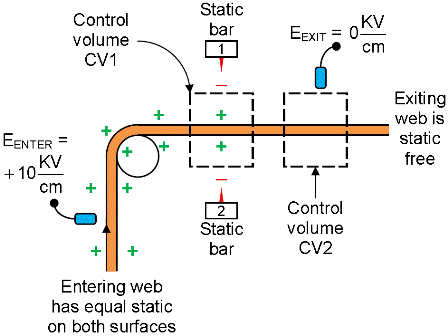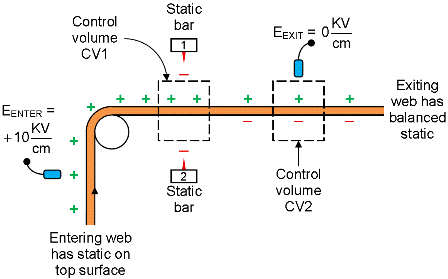Will 2 Bars Always Neutralize Static?
- Published: June 29, 2012

Figure 1: Two static bars facing each other treat both sides of the web. When the web has equal amounts of static on both sides, the exiting web is static free.
Will 2 static bars facing each other effectively neutralize static on both sides of the web?
Static control systems are designed to produce static free product. Often, we don’t really know which surface of an insulating web carries static charge. And, of course, there may be static on both sides. Can the two static bars in Figure 1 neutralize the charges on both sides of the web?
The answer is no. Two static bars facing each other have poor static control performance. They are effective only when the static charges on the two surfaces are equal. To understand the performance of these static bars, let’s analyze two cases.
In Figure 1, the entering web has an equal amount of static on both sides. The electrostatic fieldmeter reading EENTER confirms that there is a large amount of static on the web. Reading EENTER does not reveal which side is charged because the fieldmeter responds to the total amount of static on the web ... the sum of the static charge on the top side and on the bottom side.
To see how the static bars work, draw a control volume CV1 around the web between the two static bars. There are two positive charges inside CV1, so the static bars respond by generating two negative charges. Since the two static bars are mounted equally distant from the web, their response is equal and they each produce one negative charge as shown.
The negative charge from each static bar moves through the air and deposits on the web surface. The result is that the exiting web is static free. Our static bars have good performance. Fieldmeter reading EEXIT confirms that the total charge on the web is zero.

Figure 2: Two static bars facing each other treat both sides of the web. When the web has static on only the top surface, the exiting web carries static charge.
Now, let’s analyze a second case where the entering web in Figure 2 has static on only the top surface. Again, electrostatic fieldmeter reading EENTER confirms that there is a large amount of static on the web. Just as before, EENTER does not reveal which side is charged because the fieldmeter responds to the total amount of static on the web ... the sum of the static charge on the top side and on the bottom side.
Just as before, draw a control volume CV1 around the web between the two static bars. There are two positive charges inside CV1, so the static bars respond by generating two negative charges. Since the two static bars are mounted equally distant from the web, their response is equal and they each produce one negative charge as shown.
The negative charge from each static bar moves through the air and deposits on the web surface. Now, static bar 1 neutralizes only half of the charge on the top surface. And, static bar 2 adds negative charge to the bottom surface. The result is that the exiting web carries static charge. Fieldmeter reading EEXIT confirms that the charge on the web is zero, that is, that for every positive charge on the top surface there is a negative charge on the bottom surface.
Note that the electrostatic fieldmeter readings EENTER and EEXIT are identical for the two cases shown in Figure 1 and Figure 2. So, our electrostatic fieldmeter fails to distinguish between the different performance achieved in these two cases. We must be diligent in determining the location of the charges, and use an electrostatic voltmeter for confirmation.
So, our two static bars have poor performance when the static charge is on only one surface of the entering web. The only reliable way to neutralize static on both sides of the web is to follow the web path upstream and identify the sources of static charging. Neutralize the static at the source before charges can accumulate on both sides of the web. Enjoy fresh comics now. Here you'll find free xxx comics in popular genres. Go ahead and read for free.
I invite you to share your comments on this blog below. And, please feel free to suggest topics for future blogs.
My email address is:
This email address is being protected from spambots. You need JavaScript enabled to view it. .
Please feel free to visit my website:





